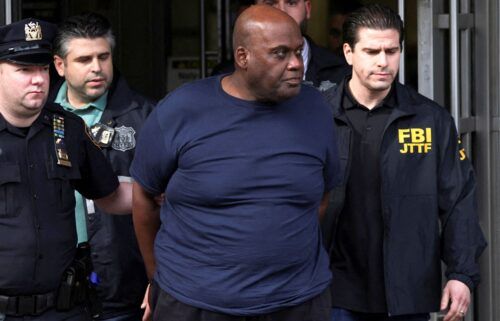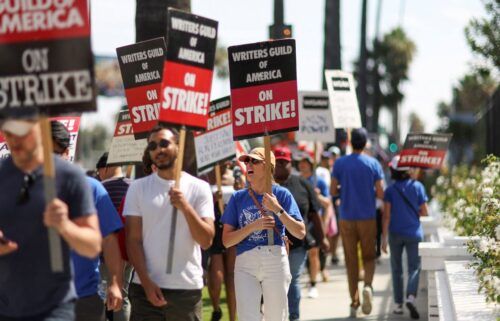Liberation has finally come to Ukraine’s Kharkiv. But scars of Russia’s brutal occupation remain
By Natalie Gallón, Nick Paton Walsh, Kostyantin Gak and Brice Lâiné, CNN
There is little respite in victory for Ukrainian forces in the recently liberated Kupiansk. Russian shells still hit its pockmarked streets, marring the skyline with plumes of black smoke.
Intense damage is visible on nearly every building. A huge billboard with an image of a waving Russian flag stands next to the bridge that crosses the Oskil River in the city center, bearing the words, “We are one people with Russia!”
For now, the Ukrainian army has chased Russian forces over the bridge and appears to be building some momentum pushing across the eastern banks of the river towards Luhansk, a key separatist territory controlled by Moscow. CNN witnessed Ukrainian infantry returning from the eastern side on foot.
Yet inside this city, one of several in the eastern region of Kharkiv that have been liberated, are the telltale signs of a hellish occupation. A former police building was used as a vast detention center by the Russians, where at one point up to 400 prisoners were held in its cramped and dark cells, with eight or nine prisoners per room, Ukrainian authorities told CNN. A brightly painted mural of a Russian soldier with a “Z” on his armband standing next to an elderly woman waving the flag of the former Soviet empire is still visible on one wall.
Before CNN was allowed to enter, a prisoner with his hands bound in glossy blue tape was quickly led outside, placed in a vehicle and driven away.
This one was possibly a Russian soldier, according to the Ukrainian Security Service (SBU), who think he either deserted his troops or was left behind. The prisoner claimed to be a local, the SBU said.
Just outside of the building’s entrance, two Russian flags tied to wooden poles were strewn on the floor, one with signs of being burned. Inside, rubbish littered the floors of the damp space. Through the narrow hallway were small rooms on each side, where Russians used to keep their prisoners.
A few small mattresses and tables were seen in some of the small cells, others held just a table and two chairs, remnants of what could have been an interrogation room.
Not all the rooms had been cleared of possible explosives, officials told CNN. A grenade booby trap sat on a bench inside a cell, held in place by a half-eaten food tin.
As CNN walked through the center, an SBU officer noticed the trap and wrote “Grenade!!!” on the wall outside the cell with a black marker and an arrow to show exactly which room investigators should enter. The door was closed.
As the investigations continue, Ukrainian officials are discovering other scars too, like those from alleged torture.
A former prisoner who was introduced to CNN by the Ukrainian Security Services said he was imprisoned in the building about a month ago. Walking through the corridor, he showed CNN the room where he said the Russians interrogated him.
“They put me on this chair,” the former prisoner — who CNN has not named for his safety — said, pointing. “There the investigator sat, and there was the guy with the telephone and another one who helped.”
The telephone was an old wind-up model that he said was used to send electric shocks into him. He thinks his interrogator was experienced in this method from their time in the Russian Security Services, the FSB.
The occupiers asked him who he was in touch with from the Ukrainian army, and told them he was once a cook in the army, he said.
“They told me, ‘You think you are tough. Let’s find out how tough,'” he said. “They also shot me with some kind of pistol. Here and in the leg,” he told CNN, pointing to his chest and leg.
“They promised I’d only see the sun and sky again if they forced me into a minefield,” he said. “The main thing is to survive and to withstand. It took me a week and a half to recover when I got out.”
The man is not the only one dealing with the scars from a brutal invasion, detention and alleged torture.
As authorities continue investigating and clearing liberated towns in the Kharkiv region, they’re finding more and more evidence of detention centers and cells used for torture.
Ukrainian President Volodymyr Zelensky said Saturday that “more than 10 torture rooms” used by occupying forces have so far been found in the area. “As the occupiers fled, they also dropped the torture devices,” he said.
CNN has reached out to the Russian government for comment but has not received a response.
Kupiansk might be recently liberated but the city is a ghost town, punctuated by destruction and debris.
The very few locals that remain huddle in its empty husk.
The-CNN-Wire
™ & © 2022 Cable News Network, Inc., a Warner Bros. Discovery Company. All rights reserved.



